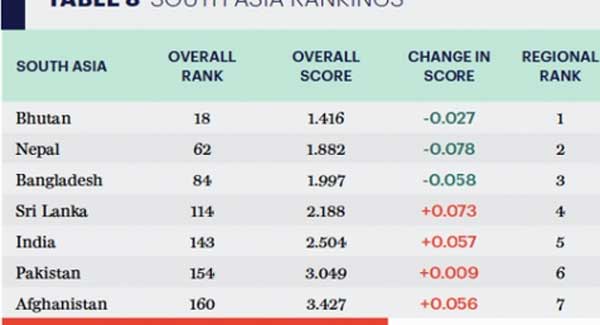
Dhaka, Bangladesh (BBN)-Bangladesh is the third most peaceful country in South Asia while Bhutan and Nepal secured the first and second positions in terms of peaceful country, said a new global report.
The overall ranking of Bangladesh is 84 though its regional raking is third with an overall score of 1.997, said the 2015 Global Peace Index. However, the changes show as '-0.058'.
Sri Lanka, India, Pakistan and Afghanistan secured the fourth, fifth, sixth and seventh positions respectively in the South Asia.
Bangladesh is even ahead of the United States in terms of peace as its overall ranking 94 while Bangladesh is 84.
The index shows that the world is becoming increasingly divided with some countries enjoying unprecedented levels of peace and prosperity while others spiral further into violence and conflict.
The Global Peace Index measures the state of peace in 162 countries according to 23 indicators that gauge the absence of violence or the fear of violence. It is produced annually by the Institute for Economics and Peace.
This year the results show that globally, levels of peace remained stable over the last year, however are still lower than in 2008.
Since last year, 81 countries have become more peaceful, while 78 have deteriorated.
Many countries in Europe, the world's most peaceful region, have reached historically high levels of peace. 15 of the 20 most peaceful countries are in Europe.
Due to an increase in civil unrest and terrorist activity, the Middle East and North Africa is now the world's least peaceful region for the first time since the Index began.
Globally the intensity of internal armed conflict has increased dramatically, with the number of people killed in conflicts rising over 3.5 times from 49,000 in 2010 to 180,000 in 2014.
The economic impact of violence reached a total of US$14.3 trillion or 13.4 percent of global GDP last year.
The most peaceful countries are Iceland, Denmark and Austria. The countries that made the biggest improvements in peace over the last year, generally benefited from the ending of wars with neighbours and involvement in external conflict. The biggest improvers were: Guinea-Bissau, Cote d'Ivoire, Egypt and Benin.
Syria remains the world's least peaceful country, followed by Iraq and Afghanistan. The country that suffered the most severe deterioration in peace was Libya, which now ranks 149th of 162 countries.
Ukraine suffered the second largest deterioration: following a popular revolution which brought down the administration of Viktor Yanukovych, Russia moved to destabilise the country, meaning it scored poorly on organised conflict indicators.
2014 was marked by contradictory trends: on the one hand many countries in the OECD achieved historically high levels of peace, while on the other, strife-torn nations, especially in the Middle East, became more violent.
This is a real concern as these conflict become even more intractable they spread terrorism to other states.
Steve Killelea, Founder and Executive Chairman, Institute for Economics and Peace
The world is less peaceful today than it was in 2008. The indicators that have deteriorated the most are the number of refugees and IDPs, the number of deaths from internal conflict and the impact of terrorism.
Last year alone it is estimated that 20,000 people were killed in terrorist attacks up from an average of 2,000 a year only 10 years ago.
Only two indicators have markedly improved since 2008: UN peacekeeping funding and external conflicts fought. The number of deaths from external conflict has fallen from 1,982 to 410 over the last eight years.
Peace is more than just the absence of conflict. Positive peace can be understood as the attitudes, structures and institutions that underpin peaceful societies.
The research shows that in countries with higher levels of Positive Peace, resistance movements are less likely to become violent and are more likely to successfully achieve concessions from the state.
BBN/SK/AD